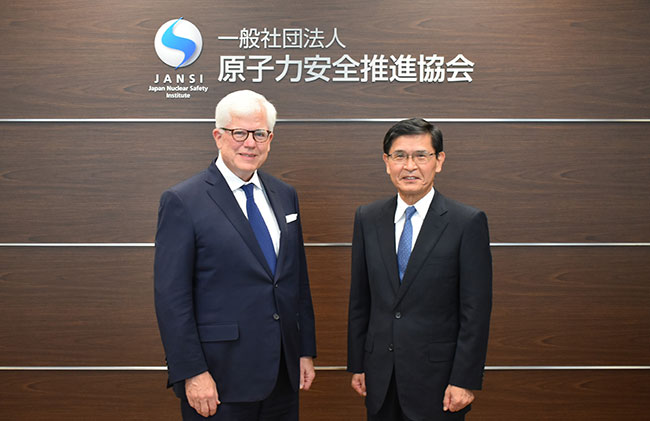A figure from the “Multistep Coulomb excitation of 64Ni” that shows the time-of-flight difference between the projectile and target recoils as a function of scattering angle measured with the CHICO2 detector. A clear separation between the Ni-64 (bottom) and Pb-208 (top) ions is observed. (Credit: Physical Review C/American Physical Society)
A study published recently in the American Physical Society journal Physical Review C reveals new findings about the strong nuclear force, the mysterious fundamental force that holds together the protons and neutrons of the atomic nucleus. Experiments conducted at Argonne National Laboratory have shown how the round, heavy nuclei of the nickel-64 isotope (containing 28 protons and 36 neutrons, making it the heaviest stable Ni isotope) changed into one of two shapes—either like a doorknob or a football—depending on the amount of energy exerted on it. A summary of the research on the Phys.org website compares the nuclei shape change to popcorn kernels changing shape when heated in a microwave.
The Yakutia awaits launch at St. Petersburg’s Baltic Shipyard on Nov. 22. (Photo: TASS/Valentin Yegorshin)
Advancing its efforts to develop the Arctic and establish new energy markets, Russia launched a new nuclear-powered icebreaker, the Yakutia, in St. Petersburg during a November 22 ceremony. At the launching in the northern Russian port city, the Russian flag was raised on another nuclear icebreaker, the Ural. Overseeing the events via video link from the Kremlin, Russian president Vladimir Putin said that the icebreakers “were laid down as part of a large serial project and are part of our large-scale, systematic work to reequip and replenish the domestic icebreaker fleet, to strengthen Russia's status as a great Arctic power.”
The JET tokamak. (Photo: European Consortium for the Development)
Nuclear fusion “might actually be on the cusp of commercial viability” today, says a recent article in Fortune magazine. The article offers a brief review of recent technical and entrepreneurial developments in fusion energy. It also places these developments in perspective regarding the hurdles that remain before commercialization can be realized.
Diagram of the University of Rochester Laboratory for Laser Energetics’ OMEGA laser system. (Image: University of Rochester)
A study recently published in Nature Communications brings a new perspective on how radiation travels through dense plasmas, potentially leading to a better understanding of the evolution of stars and the development of controlled nuclear fusion reactions. Researchers led by investigators at the University of Rochester Laboratory for Laser Energetics (LLE) achieved their findings by conducting experiments with LLE’s OMEGA laser system. This extensive system, which is 19 meters tall and 70 meters long, consists of 60 laser beams that can focus as much as 30,000 joules of energy onto a target for the study of nuclear and fluid dynamic events.
JANSI’s chairman William Edward Webster Jr. (left), and president and CEO Hiromi Yamazaki. (Photo: JANSI)
The Japan Nuclear Safety Institute (JANSI) marked its 10th anniversary on November 15 by publishing a letter that highlighted some of the organization’s greatest accomplishments of the past decade. In the letter, William Edward Webster Jr., chairman of the JANSI board of directors, and Hiromi Yamazaki, JANSI president and chief executive officer, expressed their “sincere gratitude to all our members and other stakeholders who have provided support and guidance over the past 10 years.”
The TRIGA Mark II nuclear research reactor. (Photo: University of Texas)
The Nuclear Regulatory Commission has conducted a special inspection at the University of Texas’s TRIGA Mark II nuclear research reactor in Austin to evaluate the use of improper fuel. The inspection was ordered following a notification from the University of Texas—Austin to the NRC that the research reactor had been operating for several months with two fuel elements that were not licensed for the reactor.
The molten salt test loop at ACU’s NEXT Lab. (Photo: Jeremy Enlow/SteelShutter)
The Nuclear Regulatory Commission has announced that it will review a construction permit submitted by the Nuclear Energy eXperimental Testing (NEXT) Laboratory at Abilene Christian University for the lab’s planned molten salt research reactor (MSRR). The NRC informed Rusty Towell, director of the NEXT Lab and professor in ACU’s Department of Engineering and Physics, about its acceptance of the construction permit review in a November 18 letter. The NEXT Lab had submitted the construction permit application on August 15; it was the first-ever university application for an advanced research reactor. On October 14, they provided the NRC with additional information about instrumentation and controls. (Nuclear News featured an article about the NEXT Lab and the MSRR in the November issue.)















 Nuclear energy “has exceptional characteristics that make it uniquely qualified to address all three facets of the energy trilemma: affordability, sustainability, and reliability,” according to a new report,
Nuclear energy “has exceptional characteristics that make it uniquely qualified to address all three facets of the energy trilemma: affordability, sustainability, and reliability,” according to a new report,